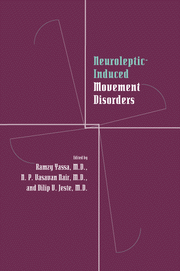Book contents
- Frontmatter
- Contents
- Contributors
- Preface
- Part I Historical perspective
- Part II Clinical aspects of tardive dyskinesia
- Part III Mechanisms underlying tardive dyskinesia
- Part IV Measurement of tardive dyskinesia
- Part V Tardive dyskinesia in different populations
- Part VI Other neuroleptic-induced movement disorders
- 24 Drug-induced parkinsonism
- 25 Clinical aspects of neuroleptic-induced dystonia
- 26 Tardive dystonia
- 27 Tardive akathisia
- Part VII Treatment of tardive dyskinesia
- Index
27 - Tardive akathisia
from Part VI - Other neuroleptic-induced movement disorders
Published online by Cambridge University Press: 09 October 2009
- Frontmatter
- Contents
- Contributors
- Preface
- Part I Historical perspective
- Part II Clinical aspects of tardive dyskinesia
- Part III Mechanisms underlying tardive dyskinesia
- Part IV Measurement of tardive dyskinesia
- Part V Tardive dyskinesia in different populations
- Part VI Other neuroleptic-induced movement disorders
- 24 Drug-induced parkinsonism
- 25 Clinical aspects of neuroleptic-induced dystonia
- 26 Tardive dystonia
- 27 Tardive akathisia
- Part VII Treatment of tardive dyskinesia
- Index
Summary
Akathisia has been aptly described by Stahl (1986) as “a stepchild of movement disorders and an orphan of psychiatry.” In the past, many neurologists dealing with movement disorders considered akathisia not as any particular pattern of movement but rather as a subjective state characterized by a feeling of restlessness (Crane & Naranjo, 1971; Chase, 1972). Thus it was not considered to be a movement disorder. On the other hand, because akathisia was not listed in either the diagnostic index or the symptom index of the Diagnostic and Statistical Manual of Mental Disorders, third edition, revised (DSM-III-R) (American Psychiatric Association, 1987), its status as an abnormal subjective state was ill-defined within psychiatry. Akathisia's uncertain status probably has contributed considerably to its neglect as an important and disabling neurological and psychiatric condition. Until recently, the persistent form of akathisia due to neuroleptics, referred to as tardive akathisia, has been particularly neglected. The early reports of classic oral-buccal-lingual tardive dyskinesia included clear descriptions of chronic motor restlessness: “[the] patient cannot stand still” (Uhrbrand & Faurbye, 1960); “inability to sit still” and “pacing the floor” (Kruse, 1960); “patients could not remain seated” (Hunter, Earl, & Thornicroft, 1964). In addition, the phenomenon of acute akathisia due to neuroleptics was clearly recognized shortly after the introduction of those drugs; and it was considered one of the most common adverse effects of neuroleptics (Ayd, 1961).
- Type
- Chapter
- Information
- Neuroleptic-induced Movement DisordersA Comprehensive Survey, pp. 409 - 424Publisher: Cambridge University PressPrint publication year: 1996
- 2
- Cited by

